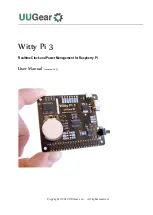
COMe-bSL6 – User Guide Rev. 1.4
www.kontron.com
// 34
2.5.
Thermal Management
2.5.1.
Heatspreader and Cooling Solutions
A heatspreader plate assembly is available from Kontron for the COMe-bSL6. The heatspreader plate on top of this
assembly is NOT a heat sink. The heatspreader works as a COM Express® standard thermal interface to be use with a
heat sink or external cooling devices.
External cooling must be provided to maintain the heatspreader plate at proper operating temperatures. Under
worst-case conditions, the cooling mechanism must maintain an ambient air temperature and the heatspreader
plate’s surface temperature must remain under the maximum temperature range.
You can use many thermal-management solutions with heatspreader plates, including active and passive
approaches.
The optimum cooling solution varies, depending on the COM Express® application and environmental conditions.
Active or passive cooling solutions provided from Kontron for the COMe-bSL6 are usually designed to cover the
power and thermal dissipation for a commercial temperature range used in housing with proper airflow.
2.5.2.
Operating with Kontron Heatspreader Plate (HSP) Assembly
The operating temperature defines two requirements:
Maximum ambient temperature with ambient being the air surrounding the module
Maximum measurable temperature on any spot on the heatspreader's surface
The heatspreader is tested for the following temperature specifications.
Table 16: Heatspreader Test Temperature Specifications
Temperature Specification
Validation requirements
Commercial Grade
at 60°C HSP temperature the CPU @ 100% load needs to run at nominal
frequency
Extended Temperature (E1)
at 75°C HSP temperature the CPU @ 75% load is allowed to start
speedstepping for thermal protection
Industrial Grade by screening (E2S)
at 85°C HSP temperature the CPU @ 50% load is allowed to start
throttling for thermal protection
2.5.3.
Operating without Kontron Heatspreader Plate Assembly
The operating temperature is the maximum measurable temperature on any spot on the module's surface.
















































